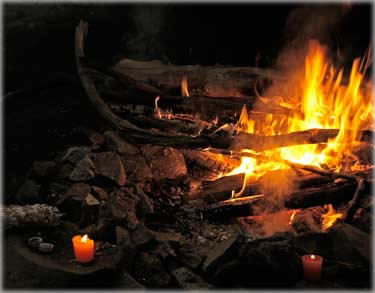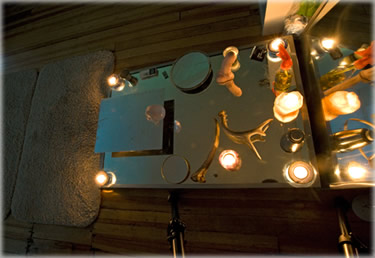Note: Eric originally published today’s archive pick in the members’ issue of Planet Waves on Oct. 22, 2010. At the time, Vesta was in Scorpio. Vesta now in Gemini conjunct the Sun and Venus is bringing its themes (such as devotion) to the forefront of consciousness; meanwhile, Mars just retrograded into Scorpio today, plunging us into the realm of instinct and desire. — Amanda P.
Dear Planet Waves Reader:
Of the mysteries of ancient Rome, the vestal virgins stand out as one of the most intriguing. Who were these women, who served half a lifetime tending the sacred fire, taken between ages six and 10, and maintaining celibacy through 30 (or more) years of service to the goddess?
 |
|
Ritual fire in the Chironian, devoted to Vesta, Rosendale, NY. Photo by Eric Francis – Book of Blue.
|
They not only tended the city hearth, keeping its flames burning around the clock; for many generations they were present at every state function, standing as guardians on behalf of the goddess Vesta, who defended the city. Philosophers and emperors, including Cicero, revered them as central points of integrity for the empire, without whom Rome would surely fail.
Vesta, the goddess of the hearth, is rarely depicted in classical art; I’ve personally never seen a representation. At the center of her temple was not a cult statue or idol, but rather a flame. She is the incarnation of the goddess as fire; the living spirit of the element.
We have the stories of the vestals , actual women who did her work. They have names and histories: Aemilia, Licinda, Fabia, Aquilia Severa and of course, Coelia Concordia, the last head of the order, who was present when the Temple of Vesta was closed in 391 when Emperor Theodosius I banned pagan practice in the empire. She stepped down in 394. Theodosius was the last emperor under whom the empire was politically unified, and the Sack of Rome occurred just 14 years later. Perhaps Cicero was right. Of that event, St. Jerome wrote, “The city which had conquered the whole world was itself conquered.”
So, it would seem that the vestals and their ritual of constant devotion, at least symbolically, held a dimension of Rome’s integrity. They could put this energy into their devotion because they were freed from the responsibilities of household relationships and child rearing. They used their time studying and working in the service of their patron goddess and in turn, the society around them.
Notably, their history seems to predate Rome itself. Rhea Silvia, the mythical mother of Romulus and Remus, the founders of Rome, was said to be a vestal virgin; she claimed that the god Mars found her in a forest and seduced her, and she gave birth to the twins.
The Discovery of the Asteroids, and Vesta
In 1801, an astronomer discovered an orbiting body for the second time ever: that was Ceres. She was named for the goddess of agriculture. Two other asteroids were discovered soon after, Juno and Pallas.
In 1807, a German astronomer named Olbers discovered an orbiting body (at the time considered a planet), which he invited a colleague to name: that was Vesta. The brightest asteroid, comprising 9% of the mass of the inner belt, Vesta is supposedly visible without a telescope. We may wonder why the ancients, who had more time on their hands and much darker skies at night, did not note her wandering amidst the stars.
Vesta was the last asteroid discovered for 38 years. In 1845, Astraea was discovered, and the following year Neptune arrived. (This page provides a chronology of minor planet discoveries.)
 |
|
Temple of the vestals on the Roman forum, reconstructed by old Benito — one of his true gifts to Italy. Photo: Wikimedia Commons.
|
The discovery of the asteroids opened the potential for additional feminine archetypes in astrology; it took about 150 years for astrologers to get going using them, and they’re still considered something of a boutique item today.
As an astrological factor, I delineate Vesta as the experience of tending the inner hearth of creativity and sexuality. Her primary quality is devotion. She also represents an organizing principle. Think of how old houses were designed around the hearth as the focal point, and how the hearth is the center of the home’s functions. Vesta describes how we organize physical space, and in a similar way, psychic space. If we devote ourselves to tending our creative processes, to tending our inner flame, we have a way to organize consciousness that is then reflected in our values and our expression of life force.
People with a strong Vesta placement will almost always have an unusual expression of sexuality. By strong placement, I mean making many aspects, conjunct the Sun or Moon, or placed on one of the chart’s angles — such as the ascendant or midheaven. Their relationship lives will ‘just be different’ than the people they know: the typical models of romance don’t quite work, and they will wonder why. Many with this kind of placement will be inclined to think it’s a relationship issue, and feel inadequate; with Vesta, the root of the matter is often how sexuality is processed differently. There is the element of service, and Vesta may be incarnating in her expression as the sacred prostitute.
Sacred prostitution means offering oneself sexually in the service of creation, or the service of the goddess, as you wish, but often another person is the direct beneficiary. This is the kind of erotic sharing that is neither romantic nor casual. It’s not quite a mutual marriage. It’s part of what I call the Third Way. Many people have touched upon this energy, but in my experience relatively few experience it consciously or consistently. Typically, we lack the language and the support systems that make it feasible, and we tend to take everything — and everyone — much too personally.
With a strong Vesta placement, there can also be an element of celibacy: that is, of long gaps in sexual activity, which can be particularly confusing for young women who are accustomed to getting plenty of sexual attention. It helps to hear about Vesta and the particular type of devotion she describes. This will often key in memories of past lives spent as some kind of temple priestess.
You may read other interpretations of Vesta. Martha Lang Wescott, for example, notes the mundane qualities: an obsession with projects instead of people; emotional distancing; hard work and career demands; being impersonal; sublimation of other interests into the career or vocation; sacrifice/denial of self (by others/self) for a ‘greater goal’.
One author I read in The Mountain Astrologer circa 2000 said he noticed intense experiences of shame around Vesta placements, often relating to sex and inappropriate childhood sexual contact. I think all these concepts are valid, and some are rather perceptive, yet what is central to Vesta — and to any planet — is the process that unites all of the seemingly separate definitions.
With Vesta, that process involves the devotion of tending the inner hearth, be it for creativity, healing or service. At the center of our inner space is the fire of the soul that, in the complexities of physical life, rarely seems to burn on its own — it needs to be tended, loved and honored continually, so that it can thrive and flourish. When the flame is tended, the empire of our lives can thrive because there is integrity at the core of who we are, and fidelity to our purpose.
Venus Retrograde, and Vesta in Scorpio
We’re now experiencing an impressive collection of planets in Scorpio, which include Venus retrograde. Vesta arrived about a week ago, and on Saturday Venus retrograde and Vesta will be making a conjunction.
 |
|
Altar to Vesta. Photo by Eric Francis – Book of Blue.
|
Venus retrograde in Scorpio is an inner quest. Retrogrades imply internal orientation, movement of awareness toward the past, the search for something hidden, and an indication of what we turned off in childhood so as not to threaten our adult caregivers.
Scorpio implies sexuality and sexual themes. Certainly, we do a lot of shutting down here; even if our parents are not hung up on religiosity or their own untended injuries, few parents of prior generations (and, sadly, few today) encourage children to be comfortable with their sexuality.
Venus, one of two feminine archetypes from classical astrology, represents all facets of women, (usually) minus the maternal aspects covered by the Moon. Venus is the lover, the yin principle, the yearning kind of desire, and the most important indicator in the chart of what we value the most.
In Scorpio, Venus represents the powerful female desire nature, which some astrologers have associated with manipulation (associated with the power aspect of Scorpio). In a sense, Venus is out of place expressing desire directly; that is more the realm of Mars. Of course, this is in the opinion of the Holy See. If we want to know what sex was like before the Christians got hold of it and took over the topic completely, we need to study the bonobos. So far, no missionary has converted a single one. They are natural people. (You can read more about them, and what their lives say about humans, in an excellent new book called Sex At Dawn: The Prehistoric Origins of Modern Sexuality.)
These critters, our closest primate cousins (with whom we share 98.5% of our DNA), use sex as a way of maintaining peace and harmony. They know nothing of the jealousy and control suggested by Venus in Scorpio. Rather, they know that keeping the energy moving keeps their society in harmony, and provides a constant source of pleasure and bonding. (The authors of Sex at Dawn note that this is something more likely to occur in a matriarchal culture than a patriarchal one.)
 |
|
Blue Pool. Photo by Eric Francis – Book of Blue, NY.
|
With Venus retrograde, we have some introspection around the theme of jealousy and control (which exist as one concept). There are people who would argue that humans are incapable of learning or inventing something better than jealousy; that it’s this thing that will always get in the way of a more open-minded approach to loving relationships.
But emotional concepts run in trends; in our control-oriented phase of cultural history, we have a reverence for jealousy that is strictly optional, and based on insecurities that are optional as well. It’s all a matter of what we want. Incidentally, that something has already been invented: it’s called compersion, which you can think of as a plus-plus symbiosis in the emotional environment. Compersion is about allowing pleasure and emotional contact to exist in others, particularly the people you love. (Here is a keynote presentation I gave recently called Community and Compersion, which explains the concept.)
Venus retrograde is a quest to release jealousy and resentment in exchange for these other values. Indeed, this is a time to question what we value at all, and to examine the basis of our investment in relationships. Think of it this way: Venus is the ruler of Taurus. The sign opposite Taurus, therefore representing relationships, is Scorpio (counting signs, the 7th place). So Venus in her opposite sign will represent a relational involvement, and the retrograde is a kind of evaluation. What is the nature of this attachment, commitment or involvement? What are the definitions and boundaries involved, and how do I feel about them?
There is the question of attachment and how it so often substitutes for love; this one is rarely asked. More than anything, the Scorpio dimension will represent the deeper layers of the emotional bonds. With Venus retrograde, we now have a little more access to information than usual about how that connects to the past, and that emotional level.
Vesta: Devotion to Sexuality
It is rare to hear someone say that they are devoted to sexuality. Most places, to admit as much invites all kinds of judgments, or the fear of being judged. Instead, we admit to wanting relationships and to certain ideas about them; we’re obsessed with the notion of a soulmate or ‘the one’; we admit to wanting comfort and security; we admit to wanting to marry for money, or the devotion to some ideal form of love. But who unabashedly admits that sex is one of their devotions? What personal ad service allows you to check that off as one of your interests?
 |
|
Heather Fae as Vestal virgin. Photo by Danielle Voirin – Book of Blue, NY.
|
Vesta in Scorpio speaks to just that common sense notion. When we consider the nuances of sexuality, we have to remember the wider cultural background that infuses the discussion and makes it all the more meaningful. Devotion to sexuality is a positive frame of reference; an affirmation of the importance and beauty of one of the best things that life has to offer, and the source of all existence. Part of the devotion is to keeping a constructive attitude, which is of course challenging when we get so few positive messages — we need to look for those messages, and dialog with them.
Think of Vesta in Scorpio as the specifically sexual flame that we must tend in order to have a healthy, wholesome existence. This tending can come in many forms, including nourishing desire, expressing that desire, encouraging ourselves to be curious, and applying our awareness to the healing projects that we know would help us. Many of these involve trust; injured trust is one of the most significant factors that affects our sexual needs. Vesta in Scorpio is about nourishing trust — in particular the kind that’s not based on the illusion of control.
There may be matters of sexual health that require regular or even daily maintenance. This is something we often take for granted. But the privy parts (as William Lilly describes them in the first description of Scorpio published in English) get a lot of other activity, and they require special care. Part of that special care is a ‘use it or lose it’ factor where sex is concerned.
There is also the dimension of knowledge. How many books about sexuality have you read? Not relationship theory; rather, books that actually consider the sexual nature of what a person is. Most of us think we know a lot about sex, but where exactly does that ‘knowledge’ come from? Even Rachel Maddow, the first lesbian prime time news anchor, can’t utter the word ‘masturbation’ when it’s called for in a news story. Part of devotion to sexuality is a commitment to awareness and honoring different viewpoints that exist, and to stretching your viewpoint. One measure of the ignorance of our culture is the current culture war being waged on same-sex lovers. There is no way that would fly unless a lot of people were scared, judgmental, ignorant and (on top of that) feeing guilty about something. That’s because attack is a projection of guilt, especially where sex is concerned.
Finally, there is the matter of tending one’s own sexual truth. Every person has a unique sexual identity; we each need different things. Every person has a unique sexual orientation: there’s a lot more than L, G, B, T and Q. Most of us try to fit our sexual orientation into a pre-fab theory that was basically forced on us as the only option. The source of that one option is usually religion — hardly a place to go for enlightened information about sex and relationships. For example, we might be bisexual or polyamorous, and try to fit ourselves into a monogamous, heterosexual concept of a relationship.
Vesta in Scorpio would say: devote yourself to who you truly are, practice authenticity about your sexuality from day to day and hour to hour, and see what happens.
The Sacred Space Within
Sexuality is deeply personal, and you may be aware of an inner sanctuary that is not someplace you regularly invite others — even your lovers. You can think of that as represented by your Vesta placement, and under the current sky, Vesta in Scorpio. In that sanctuary, you’re free to desire who and what you want, to dream any dream and to tend the flame of what makes you hot, no matter what anyone might think.
 |
|
Caroline. Photo by Eric Francis – Book of Blue, Paris.
|
Now Venus is about to enter that inner sanctum. We could look at Venus retrograde contacting Vesta as a gesture of tending that inner flame. She is about to meet the element fire, and burn off what must be cleansed. Or, we could consider that Venus has returned to the sanctuary to relight her flame, or to connect with the passion of youth. Vesta represents young women, and Venus retrograde is about older women learning from the younger ones.
Think of Venus as entering the temple with her deepest needs and desires for healing and pleasure. Imagine that she is prepared to be absolutely honest in that space, to release what she doesn’t need, and to honor the core fire of her goddess within. This is a kind of initiation ritual, where the ordinary (Venus) makes contact with the extraordinary (Vesta) in a gesture of reconsidering one’s feelings, healing the past and, soon enough, moving forward with newfound passion. There may be an element of sacrifice involved — something that you don’t need that you give up, in order to accept what you truly need or want.
The sanctuary where this exchange takes place exists at the core of our identity. It’s the place where a transformative fire burns and identity is created from moment to moment. The embers have never gone out, and if we want to rekindle the flames, now is the time.
Yours & truly,
![]()
3 thoughts on “Archive Pick: The Sacred Space of Self”
Leave a Reply
You must be logged in to post a comment.


Not quite “classical” art representation of Vesta, but pretty close: http://www.europeana.eu/portal/record/2026118/_GMS_088.html
Elizabeth — that’s a beautiful sculpture (I love Art Deco), and I do see an echo of Vesta’s chevron glyph in the figure’s overall posture. What a fun find!
One only has to consider what happened to Hera when Rome reduced her mythos to that of Juno, to see that Rome really had a problem with the divine feminine. Maybe it has something to do with the adoption of the patriarchal forms of christianity as the religion of empire. Worth checking.
Hestia doesn’t seem to have fared much better. Homer was in total awe of the Goddess of hearth, home and altar, she of the ‘holy house of the lord Apollon.’
“Hestia, you who tend the holy house of the lord Apollon, the Far-shooter at goodly Pytho, with soft oil dripping ever from your locks, come now into this house, come, having one mind with Zeus the all-wise draw near, and withal bestow grace upon my song.” (Homeric Hymn 24 to Hestia)
Here’s another image of Vesta that speaks to me of sacred space, and in any event, all roads never did lead to Rome.
http://www.sherandasilks.com/store/p16/Helios_%26_Vesta.html